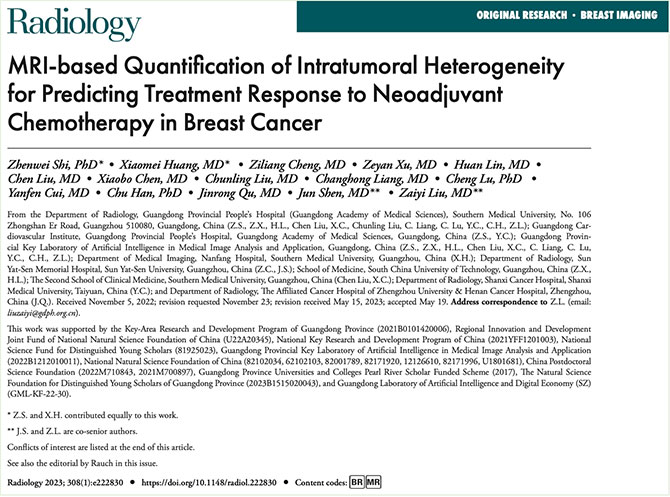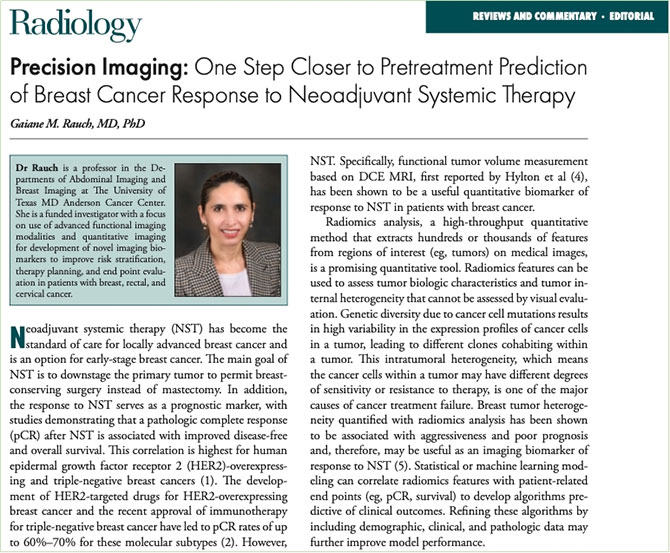

Breast cancer has become one of the malignant tumors with the highest incidence rates worldwide. Currently, neoadjuvant chemotherapy (NAC) is the standard therapy for sufferers with locally advanced breast cancer. NAC means systemic chemotherapy performed prior to any local therapy, mainly aimed at reducing tumor load before surgery, the possibility of residual tumors, and the proliferation and metastasis of cancer cells after surgery to facilitate subsequent treatment.
However, there are significant individual differences in NAC response among breast cancer sufferers, and only about 19%-30% of sufferers can realize pathological complete response (pCR). Compared to non-pCR sufferers, it has a better prognosis and a better quality of life. However, how can we predict therapeutic effects of sufferers before NAC? Is there a predictive marker for treatment response to NAC that can identify potential pCR and non-pCR sufferer groups before surgery or even before NAC, so that physicians and sufferers no longer have to experience “trial-and-error”?
Recently, Liu Zaiyi’s and Liang Changhong’s research team from the Department of Radiology, and the Laboratory of Medical Imaging Intelligent Analysis and Application (Media Lab), Guangdong Provincial People’s Hospital published their latest study on the prediction of treatment response to NAC in breast cancer titled “MRI-based Quantification of Intratumoral Heterogeneity for Predicting Treatment Response to Neoadjuvant Chemotherapy in Breast Cancer” in Radiology, a top-tier journal in the field of medical imaging (top in CAS Q1, impact factors in 2022: 19.7) in collaboration with Shen Jun’s team from Sun Yat-sen Memorial Hospital, Sun Yat-sen University and Qu Jinrong’s team from Henan Cancer Hospital. This journal is the official journal of the Radiological Society of North America (RSNA), and is recognized as the most authoritative and best-quality academic journal in the field of imaging. Dr. Shi Zhenwei from Guangdong Provincial People’s Hospital and Dr. Huang Xiaomei from Southern Medical University are the joint first authors of this article, and Liu Zaiyi, a doctoral supervisor and Director of the Department of Radiology, Guangdong Provincial People’s Hospital, is the only corresponding author.

Beginning with the clinical challenge that treatment response to NAC for breast cancer can hardly be predicted in the early stage, this study includes the data of 1,589 female breast cancer sufferers from multiple centers around the world, and proposes an AI algorithm based on routine examination enhanced magnetic resonance imaging data to predict treatment response to NAC for breast cancer sufferers. This model has shown good generalization in multicenter, large sample data validation, laying the foundation for future clinical application and extension.
This study also proposes an MRI-based tumor ecological diversity index innovatively to assess the intratumoral heterogeneity (ITH) of breast cancer, and builds a prediction model combining clinical pathological information and traditional imaging omics features. It is found that the breast cancer ITH index based on DCE-MRI before NAC is an independent predictor of NAC efficacy, and provides a biological basis for the clinical application of the NAC efficacy assessment model for breast cancer.
“This method can help identify potential beneficiary sufferers and select appropriate therapeutic schemes; for non-beneficiary sufferers, adjusted therapeutic strategies can be considered. This study witnesses significant clinical application value.” Liu Zaiyi introduced.
Prof. Gaiane M. Rauch, Director of Breast Molecular Imaging and Director of the Functional Imaging Laboratory at the MD Anderson Cancer Center, University of Texas, published a concurrent review article on this study in Radiology, pointing out that this study not only uses a multicenter, large sample dataset to build and validate an individualized model for predicting the efficacy of NAC for breast cancer, but also proposes an analytical algorithm for tumor sub-regions innovatively to assess the spatial heterogeneity of breast cancer tumors quantitatively. The model developed by the team, along with the MRI-based quantitative analysis before NAC and sufferer-specific clinical pathological information, is used to predict treatment response to NAC in breast cancer sufferers, and is another development in the field of precision imaging.

The publication of this study is a successful example of multicenter and multidisciplinary cooperation in imaging AI research. In view of the clinical challenge that the efficacy of NAC for breast cancer can hardly be predicted in the early stage, Liu Zaiyi’s team proposed a quantitative assessment method of tumor heterogeneity based on routine magnetic resonance imaging examinations of breast cancer innovatively, and validated its prediction efficiency and the generalization of the model using multicenter, large sample data. These findings provide a reliable basis for clinical decision-making in the early-stage intervention and management of NAC for breast cancer sufferers, and critical support and guidance for clinical application and transformation. This research achievement stands in the first echelon in the global field of breast cancer radiological imaging. In addition, Liu Zaiyi’s team is transforming the research achievement actively in hopes of providing a more powerful decision-making tool for the individualized precise diagnosis and treatment of breast cancer sufferers.
Department of Radiology
Updated: July 13, 2023